By Harald Zoschke, CHILI-BARBECUE.DE
Chile Hack # 1
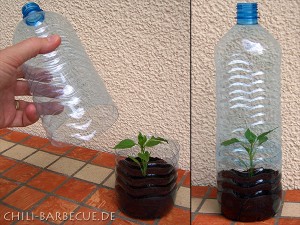 Here’s an idea for an “el cheapo” mini-greenhouse for young pepper plants: Cut off the lower third of a large water bottle, poke a small hole in the bottom, insert soil and your small plant, and water it. Make a 5 cm vertical cut in the upper part so you can carefully mount it over the lower part. Don’t forget to check on water every now and then, and to replant in time.
Here’s an idea for an “el cheapo” mini-greenhouse for young pepper plants: Cut off the lower third of a large water bottle, poke a small hole in the bottom, insert soil and your small plant, and water it. Make a 5 cm vertical cut in the upper part so you can carefully mount it over the lower part. Don’t forget to check on water every now and then, and to replant in time.
Chile Hack # 2
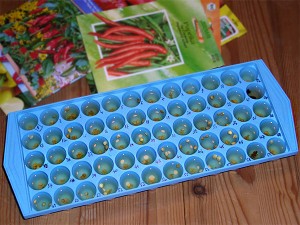 Many chile gardeners prefer to soak their pepper seeds in bleach solution, tea or plain water before sowing. If you have a lot of varieties, that means a lot of small containers. Or you follow my advice to use ice cube trays. If you’re lucky (like me), you’ll find one for tiny “cubes” – like shown, with 60 compartments. Alternatively, a pill box for a 4-week supply offers compartments to soak seeds for up to 28 varieties. Be sure to number your compartments with a waterproof felt-tip pen and take notes what you put where, or you’ll be in trouble.
Many chile gardeners prefer to soak their pepper seeds in bleach solution, tea or plain water before sowing. If you have a lot of varieties, that means a lot of small containers. Or you follow my advice to use ice cube trays. If you’re lucky (like me), you’ll find one for tiny “cubes” – like shown, with 60 compartments. Alternatively, a pill box for a 4-week supply offers compartments to soak seeds for up to 28 varieties. Be sure to number your compartments with a waterproof felt-tip pen and take notes what you put where, or you’ll be in trouble.
Depending on what liquid you’re using, soaking seeds may soften the seed casing, encourage seeds to break their dormancy or kill seed-borne diseases. We successfully used weak camomile tea particularly for hard to germinate peppers like wild chiles. But normally, especially if we’ve got rather fresh seeds, we skip the soaking process. Does soaking help? Why not try out yourself. But first, get those handy ice cube trays.
Chile Hack # 3
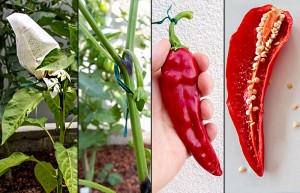 Chile peppers cross-pollinate easily, which leads to unpredictable results in the next generation grown from those seeds. If you need pure seeds, you need to protect the flower from undesired pollination by insects and let it pollinate itself. How? For single fruit you can shield a blossom with garden fleece shortly before its opening. I prefer using self-fill tea bags, available for example from Melitta. These are also made from porous filter paper and are easy to handle. Just put it over a blossom that hasn’t opened yet, and tie a piece of wire around the bottom end.
Chile peppers cross-pollinate easily, which leads to unpredictable results in the next generation grown from those seeds. If you need pure seeds, you need to protect the flower from undesired pollination by insects and let it pollinate itself. How? For single fruit you can shield a blossom with garden fleece shortly before its opening. I prefer using self-fill tea bags, available for example from Melitta. These are also made from porous filter paper and are easy to handle. Just put it over a blossom that hasn’t opened yet, and tie a piece of wire around the bottom end.
The first part of the picture shows just that. Peeking 9 days later, a nice fruit has developed. A good two months later, that fruit has fully ripened and provided plenty of pure seeds.
The example shows NuMex 6-4 Heritage. The seed supply for my favorite New Mexican chile got a little dated, so I had to produce some fresh seeds. I was not surprised that the new seeds gave me a 100% germination rate this year. Now all I need is a nice summer!
Chile Hack # 4
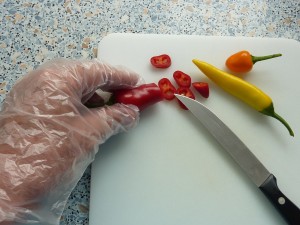 If you ever cut hot peppers and touched your eyes (or whatever) afterwards, you’ll remember that it would have been better to wear gloves. Want free gloves? Don’t throw away those diesel gloves at the gas station!
If you ever cut hot peppers and touched your eyes (or whatever) afterwards, you’ll remember that it would have been better to wear gloves. Want free gloves? Don’t throw away those diesel gloves at the gas station!
Here in Italy, one-way gloves are mandatory if you want to touch fruit or veggies on the farmers market, or in the grocery department. Don’t discard those gloves. Take an extra one. Be sure to double-cover when cutting superhots like ‘Trinidad Scorpion’.
Chile Hack # 5
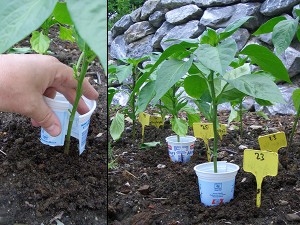 Slugs love peppers – they munch the leaves, and some even don’t mind eating the hot pods, too (we have photo evidence). Is your pepper garden at risk? You can make it harder for the slimy slugs by giving your plants a safety collar: Cut the bottom off empty yoghurt cups and make a cut lengthwise. That way you can place a cup around each plant’s stem and push it slightly into the soil.
Slugs love peppers – they munch the leaves, and some even don’t mind eating the hot pods, too (we have photo evidence). Is your pepper garden at risk? You can make it harder for the slimy slugs by giving your plants a safety collar: Cut the bottom off empty yoghurt cups and make a cut lengthwise. That way you can place a cup around each plant’s stem and push it slightly into the soil.
Start saving those empty yogurt cups now – and if you’ve got many plants, ask your friends, family and neighbors to save those cups for you, too! What a great way to recycle!
Chile Hack # 6
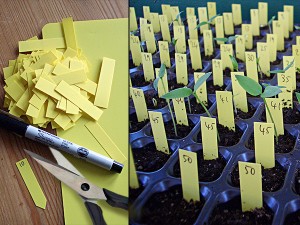 When transplanting your seedlings, you’ll need markers. Maybe even plenty of them. Here’s how to get cheap ones: Buy a bunch of plastic ring binder dividers at your office supply store. Those sturdy pages can easily be cut into shape with scissors, and just one divider page yields many, many markers that can be written on with a permanent pen like Sharpie. Sharp, eh?
When transplanting your seedlings, you’ll need markers. Maybe even plenty of them. Here’s how to get cheap ones: Buy a bunch of plastic ring binder dividers at your office supply store. Those sturdy pages can easily be cut into shape with scissors, and just one divider page yields many, many markers that can be written on with a permanent pen like Sharpie. Sharp, eh?
Chile Hack # 7
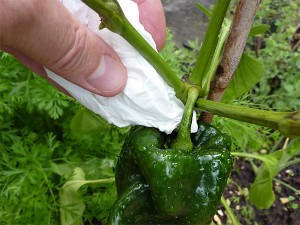 Some peppers have an indented stem attachment – poblano pods for example, and some bell pepper cultivars. When rain water collects here, this is often a place where the pods start to spoil. If you have a manageable number of such plants and pods, it can be helpful after a shower to soak up the water with paper tissue or towels.
Some peppers have an indented stem attachment – poblano pods for example, and some bell pepper cultivars. When rain water collects here, this is often a place where the pods start to spoil. If you have a manageable number of such plants and pods, it can be helpful after a shower to soak up the water with paper tissue or towels.




